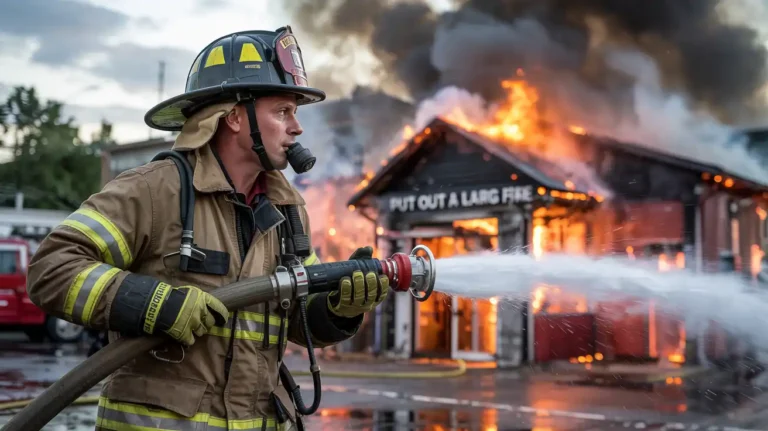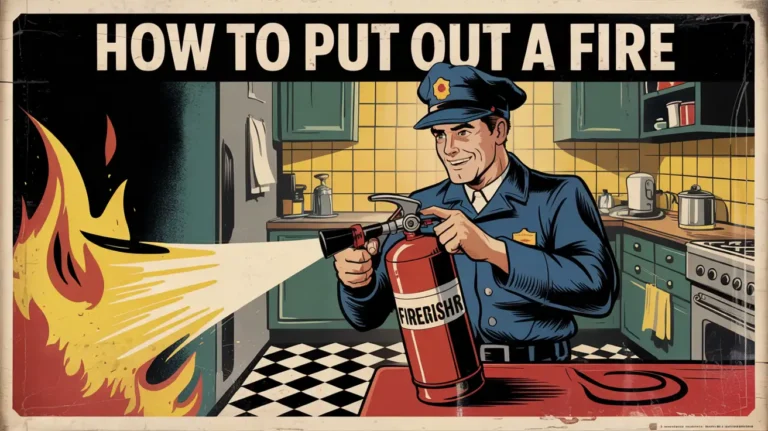Fires spread fast, and waiting even a few seconds can make a huge difference. If you’re asking how to put out a fire, the answer depends on the type of fire and the resources you have nearby. You can stop some fires with water, baking soda, or a fire extinguisher, but others need special methods. Knowing the right approach keeps you safe and helps prevent bigger damage.
This guide will walk you through different types of fires, the best way to put them out, and what to do if things go wrong. We’ll also explain when to step back and call professionals for fire damage restoration.
Table of Contents
The Science Behind Putting Out a Fire: The Fire Triangle
To stop a fire, you have to understand what makes it burn. Fires need three things to exist: heat, fuel, and oxygen. These three elements form what is known as the Fire Triangle. If you take away just one side of the triangle, the fire will go out.
There are three main ways to put a fire out:
- Cooling: This method removes the heat. Water is the most common agent for cooling a fire. It absorbs the heat and lowers the temperature of the burning material until it can no longer burn.
- Starving: This method removes the fuel. You can starve a fire by stopping the flow of a liquid or gas fuel. You can also remove solid fuel from the fire’s path, like spreading out burning logs in a fireplace.
- Smothering: This method removes the oxygen supply. By covering a fire, you prevent fresh air from reaching the flame. A fire blanket or a layer of dry powder can do this.
How Many Types of Fire Are There?

Fires are categorized into different classes based on their fuel source. Using the right type of extinguisher or suppression method is critical for safety. There are six main types of fires.
You may also read: How to Clean Smoke Damage on Walls and Ceilings Safely.
Class A Fires – Solids
What is a Class A fire? A Class A fire involves common solid materials that burn. Think of things like wood, paper, fabric, and plastic. These are the most common kinds of fires you might see in a home or office.
How do you put out a Class A fire?
The best way to put out a Class A fire is by cooling it.
- With an Extinguisher: Use a water or foam fire extinguisher. The water cools the burning material and the foam can help to smother the flames.
- Without an Extinguisher: If the fire is very small, you can use a large bucket of water. Water will douse the flames and lower the temperature below its ignition point.
Class B Fires – Liquids
What is a Class B fire? A Class B fire involves flammable liquids. These include things like gasoline, oil, paint, alcohol, and other chemicals. You will often find these types of fires in garages, workshops, or storage areas. A key point here is that water will not work.
How do you put out a Class B fire?
You must smother the fire to cut off its oxygen supply.
- With an Extinguisher: Use a dry powder or carbon dioxide extinguisher. Dry powder fire extinguishers work by forming a barrier to separate the fuel from the oxygen. Carbon dioxide extinguishers replace the oxygen in the area with CO2, suffocating the fire.
- Without an Extinguisher: Never use water on a flammable liquid fire. The water will spread the burning liquid and make the problem much worse. You can try to pour a large quantity of baking soda or sand on the fire. These will help smother the flame by blocking the oxygen. A fire blanket can also be used to cover the fire.
Class C Fires – Gases
What is a Class C fire? A Class C fire involves flammable gases. These include gases like propane, methane, or butane. This type of fire is very dangerous because of the risk of an explosion. It is crucial to act quickly and carefully.
How do you put out a Class C fire?
The most important step is to starve the fire by stopping the gas flow.
- With an Extinguisher: A dry powder extinguisher is your best option here. It is safe for use on gas fires.
- Without an Extinguisher: The first thing to do is turn off the gas supply if it is safe to do so. This removes the fuel source. Then, use a dry powder or sand to put out the fire.
Class D Fires – Metal
What is a Class D fire? A Class D fire involves combustible metals. These are rare and usually only happen in industrial settings or labs. Examples include magnesium, titanium, and aluminum shavings.
How do you put out a Class D fire?
This type of fire requires a specialized method to put it out.
- With an Extinguisher: You must use a specialized Class D dry powder extinguisher. These work by cutting off the oxygen supply and cooling the metal.
- Without an Extinguisher: Never use water on a metal fire. Water can cause an explosion. You should not try to fight a Class D fire without the right equipment. Call for professional help immediately.
Class F Fires – Cooking Oil
What is a Class F fire? Class F fires, also known as wet chemical or chip-pan fires, are a very common cause of home fires. They involve cooking oil and grease in kitchen appliances. Fire with water on a cooking fire is incredibly dangerous.
How do you put out a Class F fire?
You must smother the fire and use an agent that reacts with the oil.
- With an Extinguisher: A wet chemical fire extinguisher is designed specifically for this type of fire. It creates a foamy layer that cools and seals the oil, preventing re-ignition.
- Without an Extinguisher: The best way to put out a fire in a pan is to smother the fire by covering it. Use a metal lid or a cookie sheet to cut off the oxygen supply. Turn off the heat source. You can also pour a large amount of baking soda or salt on the fire. Do not use flour. Flour is a fine dust that will act as a fuel and make the fire worse.
Electrical Fires
What is an electrical fire? An electrical fire is caused by faulty wiring, overloaded circuits, or malfunctioning appliances. These fires are not a class themselves but are a type of ignition source. The fuel could be anything from wires to the wall behind them.
How do you put out an electrical fire?
The most important step is to cut the power source.
- With an Extinguisher: Use a CO2 or dry powder extinguisher. These extinguishers are non-conductive, meaning they will not transmit electricity. This is crucial for your safety.
- Without an Extinguisher: The first step is to unplug the device or turn off the power at the main breaker. This removes the ignition source. If it is a small flame, you can try smothering the fire with a non-conductive item like baking soda. Never use water on an electrical fire. Water conducts electricity and could cause a fatal shock.
The Fire Extinguisher Method: PASS
When using a fire extinguisher, remember the acronym PASS.
- P – Pull: Pull the pin at the top of the extinguisher.
- A – Aim: Aim the nozzle low, at the base of the fire.
- S – Squeeze: Squeeze the handle to release the extinguishing agent.
- S – Sweep: Sweep the nozzle from side to side at the base of the fire until the fire is out.
What If the Extinguisher Doesn’t Put Out the Fire?

Remember that you are not a professional firefighter. If a fire starts to spread and becomes too large for you to put out, you must get out immediately. Your safety is the number one priority. Do not go back inside for any reason. Get out, stay out, and call 9-1-1.
Additional Fire Safety and Suppression Tips
- Have an escape plan: Practice a fire escape plan with your family. Make sure everyone knows at least two ways out of every room.
- Check smoke alarms: Test your smoke alarms every month and replace the batteries once a year.
- Install fire extinguishers: Place a fire extinguisher on every floor of your home and in your kitchen and garage. Ensure everyone in the house knows where they are and how to use them. The best way to put out a fire is to be prepared.
- Maintain your appliances: Regularly check electrical cords for damage. Avoid overloading outlets.
- Be careful with candles: Never leave a lit candle unattended.
- Proper storage: Keep flammable liquids and materials in a safe place, away from heat sources.
These fire safety tips and a solid understanding of fire suppression can make a major difference. A small home fire is frightening, but knowing what to do can turn fear into effective action.
Choose San Diego Home Remodeling for Fire Damage Restoration
If you have experienced a fire in your home, the damage can be devastating. After the flames are out and the fire department has left, you may be left with extensive smoke and water damage San Diego services are needed to fix. Our team at San Diego Home Remodeling specializes in fire and water damage restoration. We can help you rebuild and restore your property.
We understand the emotional toll of a fire. Our experts work with you every step of the way to make the process as smooth as possible. We offer full-service restoration to bring your home back to its original state.
Conclusion
Knowing how to put out a fire is an integral component of personal safety. By understanding different types of fires and how best to respond to them, you will be better prepared in case of an emergency situation. Remember the basics: starve, smother or cool. Whether using an extinguisher or household item, being calm and prepared are key ingredients of achieving positive outcomes; always prioritize personal safety above anything else and know when calling in experts is necessary.
FAQs
Can baking soda really put out a fire?
Yes, baking soda can smother small fires. When heated, it releases carbon dioxide gas, which helps to starve the fire of oxygen. It is best used on small grease or electrical fires.
Is it safe to use a fire extinguisher in an enclosed space?
Using a CO2 or dry chemical extinguisher in a small, enclosed space can be dangerous. The agent displaces oxygen, which can make it hard to breathe. Always make sure you have an escape route and get out immediately after using the extinguisher.
Do I need a fire extinguisher at home?
Yes, owning a fire extinguisher is a smart investment. It can help you quickly put out a small fire before it spreads. Look for a multi-purpose extinguisher rated ABC, as it can be used on many common types of fires.
How do you put a fire out with water?
Water is most effective on Class A fires (solids like wood and paper). It works by cooling the fire. Never use water on electrical fires, grease fires, or flammable liquid fires, as it can cause the fire to spread or result in electric shock.
What is the best way to put out a fire without an extinguisher?
For small fires, the best method is to smother the fire. You can use a fire blanket, a metal pot lid, or even baking soda to cut off the oxygen supply. For ordinary fires (wood, paper), water is an option if the fire is small.








